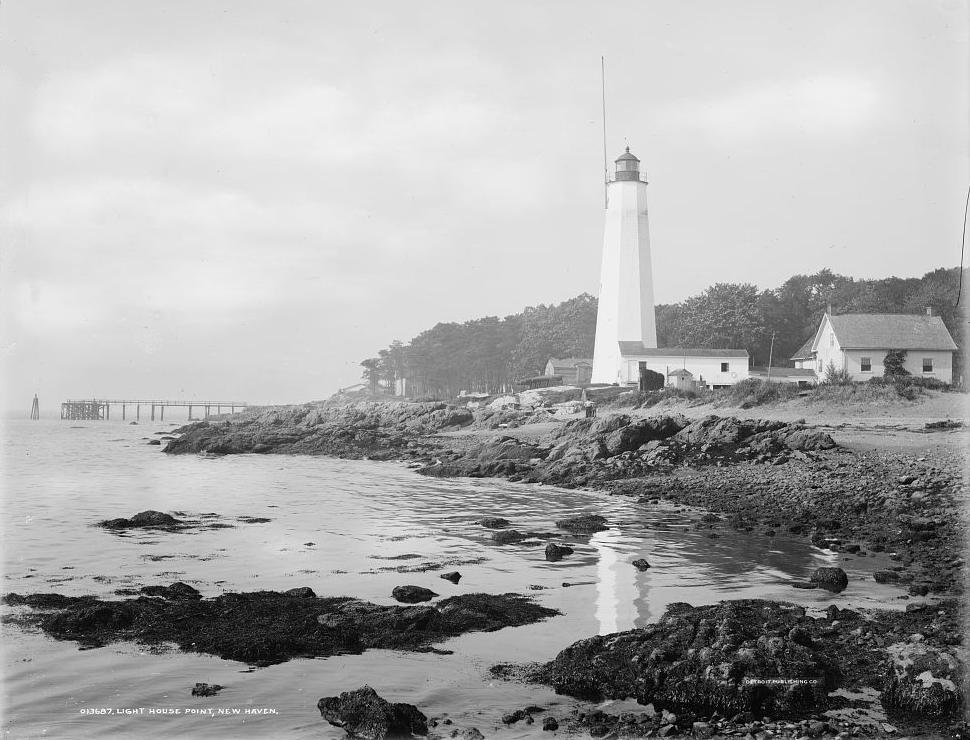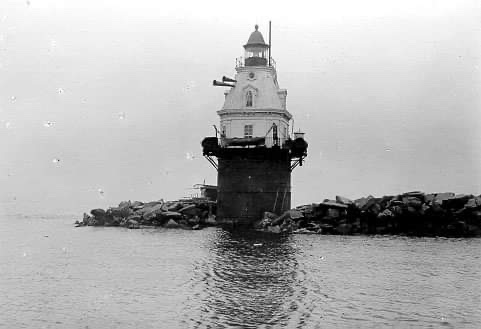In mid-November, I started reading Virginia Woolf’s To the Lighthouse and, like James Ramsay, one of the novel’s main characters, I developed something of an idée fixe about visiting one. Lighthouses embody a contradiction I wanted to understand––they are, in Woolf’s words, “endlessly suggestive signifiers of both human isolation and our ultimate connectedness to each other.” The timing seemed right to reconcile the two: I had recently recovered from COVID-19 and finished a lonely quarantine. So on a wind-bitten day before Thanksgiving, I trekked out to Five Mile Point lighthouse, which sits on a promontory at the lip of New Haven Harbor. I was hoping for illumination––what else would a lighthouse provide?––to see whether visiting the place, as if consulting an oracle, might resolve the antithesis Woolf identified.
On the beach, Five Mile Point lighthouse is massive and deceptively everywhere. Swivel your head in any direction and it will eventually show itself. I climbed the staircase leading to the optic section at the top of the lighthouse––a 74-step spiral that narrows like the chamber of a seashell––with the sound of shards of stone crunching under foot caroming off the walls. Late in the day, the glass enclosure, seventy feet in the air, no more than six feet in diameter and eight in height, fills with sunlight but does not glow. The scene expands but the room constricts.

Lighthouse Point, New Haven
From this vantage, at the tower’s crown, New Haven’s skyline looks small and secret, like it was never supposed to be seen from this side, denuded of smokestacks and golden when the sun is low. The view is about the boldest illustration of New Haven’s conquest of the coast. Looking out, I could see all of the city from City Point to the East Shore and, on the horizon, oil tankers and oyster fishers navigating the waters, a marriage of the new and old New Worlds. New Haven follows a rule about coastal cities: their progress depends on their mastery of the sea. Mastery of the sea was impossible without a lighthouse.
For thirty years, Five Mile Point did what it could to guide seafarers into port, but because it was situated too far inland, its light was dim to the point of invisibility in thick fog and ships kept running their keels over the rocks in the harbor. In 1877, the lighthouse was decommissioned, stripped of its fog bell and 4,000-pound lens. On the inside, all that’s left is the view out. At the top of Five Mile Point I realized, as James Ramsay eventually does, that the allure of lighthouses is in the distance from them—that I was only in “a stark tower on a bare rock.”
Across the water, I could faintly make out New Haven’s other lighthouse, the active one, Southwest Ledge Light. And though I had just come to understand what reaching a lighthouse does to its allure, what is lost in the summit, I wanted to get closer.
***
I couldn’t. Southwest Ledge Light is privately owned but under the Coast Guard’s jurisdiction. Hoping to catch a ride out to the island on one of the Coast Guard’s regular maintenance visits, I called the New Haven station so many times that the officers started to recognize my voice (“ayyy, it’s you again!”). They told me it would be months before conditions would be right for a trip out and even then nothing was guaranteed. In the meantime, photographs of the lighthouse would have to suffice.

Southwest Ledge Lighthouse
The photographs seemed to capture what the early American daguerreotypist Albert Southword said the medium can: the “soul of the subject itself.” Because they have the features of a body––neck, face, and complexion––and suggest an inner life with cycles of ruin and grace, lighthouses have been ripe for anthropomorphizing. A picture taken by the Coast Guard in 1903 shows Southwest Ledge Light pallid and forgotten––the soul of a different American Gothic. The lighthouse stands on less than an acre of breakwater, an artificial landing made from the rubble of underwater rock, or “riprap.” Its footprint extends no longer than a brontosaurus from tail to jaw and the boulders that jut toward the mainland, shrinking as the water deepens, resemble vertebrae. The smallness of the island is apparent and the water in the foreground twists like in a Munch painting. The lighthouse’s Second Empire exterior and mansard roof were meant to make it look homey, but to today’s eyes the structure looks haunted, as if a turret of a Victorian mansion had harpooned its way through the rock, leaving the rest of the house submerged.
Given the building’s eeriness, I wondered whether it had been the scene of something brutal. Journal entries from the winter of 1907-8 confirmed my suspicion, prefiguring the plot of Robert Eggers’ 2019 period horror film The Lighthouse: an assistant tried to kill the head keeper twice, the first time with a fire axe, the second with a butcher’s knife. Failing, he rowed to shore and committed suicide. Lighthouse folklore is replete with other accounts of madness: the first two keepers at the Phare de Tévennec, a lighthouse off the coast of Brittany, were driven insane by what they believed were the voices of ghosts; Theed “Crazy” Judson, a keeper at Stratford Point Light in Connecticut, claimed to have seen sea serpents and mermaids rising from the water.
The trope of the deranged lighthouse keeper is easy to rationalize. The labor and repetition were relentless: every night polishing the lens of the lamp, stoking the fire within it with explosive whale oil, cranking the light nonstop during storms, and enduring the blow of the foghorn every fifteen seconds, like a clockwork song of the sirens, sometimes for weeks on end. A keeper’s day might leave too little room for quiet contemplation, or too much. “The trouble with our life here,” said Milton Herbert Reamy, a Massachusetts keeper, “is that we have too much time to think.” What’s more, some scholars speculate, in bathing their lenses in liquid mercury to reduce the friction of the bearings beneath the lamp, keepers inadvertently poisoned themselves and triggered a kind of psychosis, more commonly known as mad hatter syndrome. Boredom, hard labor, and chemical exposure were a perfect storm many keepers could not weather.
***
But the job was done nonetheless, and done for millennia, all the way back to the Phoenicians, who built a network of navigational aids throughout the Mediterranean––temples with eternal flames that priests lit at night. The Greeks did the same with their city-states. The Romans built towers at Ostia, Ravenna, Pozzuoli, Messina, Dover, and Boulogne, each integral to the settlement of port cities and the empire’s expansion. Controlling light made longer voyages possible and with them a larger geography of exchange and war, connecting mariners to the land and civilizations with one another. Centuries later, lighthouses became some of the world’s first non-military public works, adding nuance to the role of the state and laying the foundation for its infrastructure.
Every empire learned pharology, the science of lighthouse construction, named after the island of Pharos, where the famous Lighthouse of Alexandria was built. Long after the Lighthouse of Alexandria became a ruin and Rome an idea, the modern empires of France, Britain, and America advanced the art. The Tour de Cordouan in France, completed in 1611, was the first lighthouse to use a Fresnel lens, the invention said to have “saved a million ships.” A Fresnel lens looks like a twelve-foot-tall Fabergé egg made of glass with concentric rings etched on the surface in the shape of rippling water. It aligns an array of prisms on incrementally more dramatic angles to collimate, or make parallel, the rays of light from an oil lamp, concentrating them into a single intense beam. By the mid-19th century, most lighthouses had one. Fresnel lenses were also used in early car headlamps, movie projectors, cameras, and aircraft carrier landing strips. Many modern conveniences still have a little lighthouse in them.
Most lighthouses today don’t use a Fresnel lens. Blinking LEDs have replaced them and GPS, VHF radio, and other computer electronics have reduced them to failsafes. All but a few have been automated. There are still a few dozen civilian keepers, but the last generation of keepers in the Coast Guard has dwindled to one: Sally Snowman, who has been tending the light in Boston Harbor for the past 17 years. Snowman’s post is mandated by an act of Congress, which made Boston Light, the oldest lighthouse in the country, a kind of antiquarian simulation of what it once was.
Boston Light’s old Fresnel lens shines a warm beam for 20 miles more than is needed to bring ships into port, but, according to Snowman, its intensity feeds a longing in the psyche, its sweeping rays coming down “like a shield to the horizon.” The light “means many things to people on metaphysical and spiritual levels,” she told me, “and they don’t want to see that go.” For an opening bid of 10,000 clams, they don’t have to. The National Historic Lighthouse Preservation Act of 2000 set off a surge in the buying of derelict lighthouses: Southwest Ledge Light was auctioned off, in 2016, to Beacon Preservation, which owns lighthouses up and down the Atlantic seaboard, and the Werth Family Foundation; earlier this year, Chesapeake Bay Lighthouse, offshore in Baltimore, was sold to a private buyer for upwards of $60,000; and there are now five lighthouses on the Great Lakes alone up for auction. Some bid for their beauty, others for what they hope they might reveal.
***
Tonight in New Haven Harbor, having slept through the day, Southwest Ledge Light’s lamp will spin. Tomorrow night it will do the same. And seemingly forever in a convergence of systems: ancient and modern, utilitarian and romantic, rational and uncanny, the deep alone and the always together. In believing that I would find some meaning by making it to the lighthouse, I committed an error of reification, mistaking the concrete for its idea, the place for what it symbolizes. Southwest Ledge Light and its terrain are still a mystery to me and I’d like to keep it that way. Knowing its stairs are there, and that they lead somewhere, is enough.
— Zachary Groz is a sophomore in Jonathan Edwards College and an Associate Editor.


